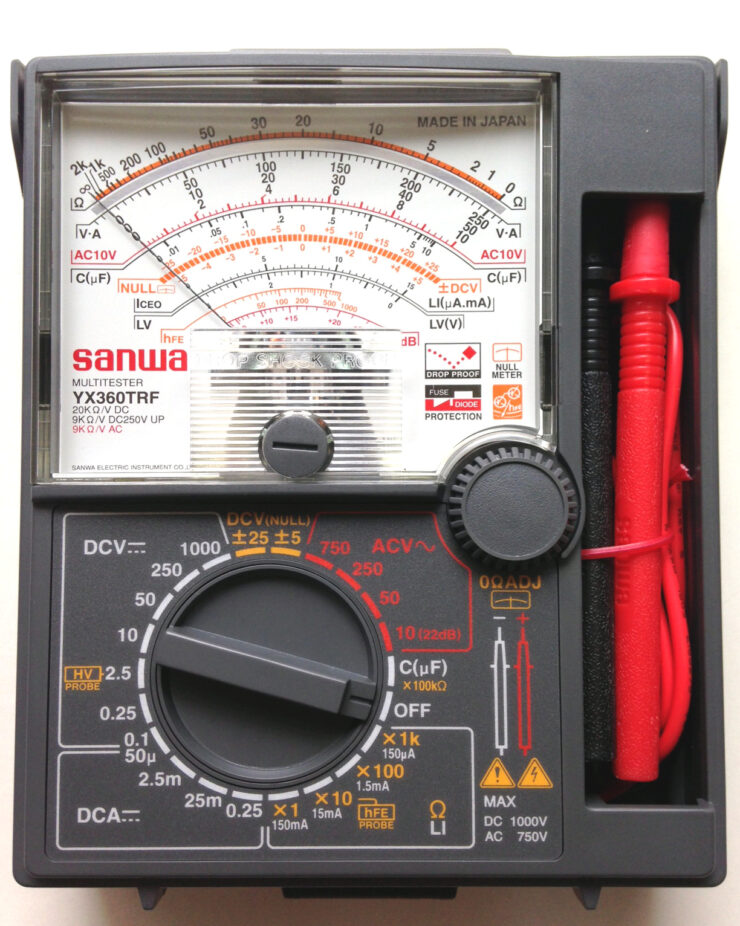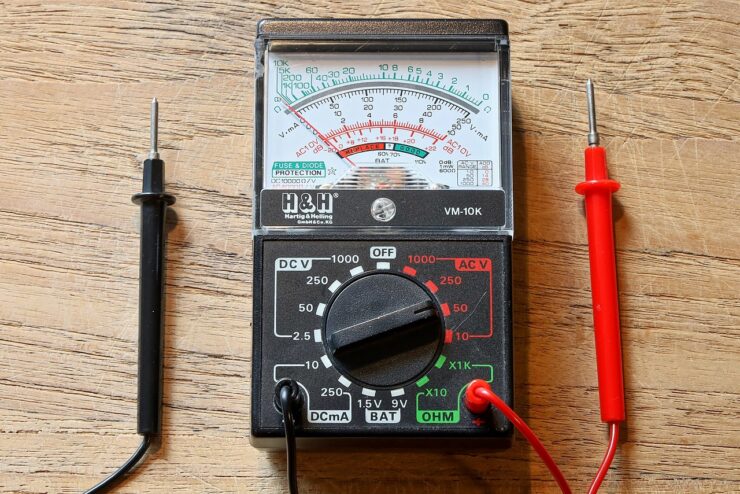The analog multimeter is a handy and beneficial instrument utilized to calculate electrical parameters and magnitudes. If you have no idea how to use analog multimeter, here we give you a complete guide. Analog multimeter is a small device with an interface with a pointer that calculates a variety of electrical quantities.
Older analog testers were equipped with a “moving iron” measurement system, but the newer ones are built with a “moving coil” measurement system. This coil is built with a wire, a spring, and a needle, which is what we can see in the interface. When an electric current surpasses the coil, an electromagnetic field is created.
Read more about: Best HVAC Multimeter
However, the attraction between this field and the magnet makes the coil rotate. Which at the same time makes the needle move so that we can check the measurement. The analog multimeter has a wheel with different values and different measurement ranges: alternating current (AC), direct or direct current (DC), resistance, and current intensity (voltage).
Also, it has two terminals or connectors where two tips (red and black) are placed that are used to measure the different values. Let us find out how to use it correctly and what are the differences between analog and digital multimeter?
How to Use Analog Multimeter?

Analog multimeters are pointer instruments that can calculate a range of electrical quantities. Analog multimeters, in addition to measuring magnitudes, analog multimeters for current, voltage, and resistance professionals in different measurement ranges.
They are also ideal for diode or continuity tests. Modern analog multimeters are typically equipped with a moving coil measurement system. The first generation analog multimeters, however, were equipped with a moving iron measurement system.
These types of multimeters are used in schools, training companies, laboratories, universities, and the research sector. Analog multimeters are suitable in these fields of application due to their fast recording and subsequent presentation of the measured values. In this way, the trends are recognizable easily.
To check the accuracy, analog multimeters can be calibrated by a licensed and certified calibration lab. This ensures that analog multimeters can be used in ISO certified companies. Some analog multimeters have a mirror band built into the scale field.
When taking the reading of the measurement value on these analog multimeters, the angle of view must be chosen in such a way that the needle and its image in the mirror are congruent. Other analog multimeters have a needle flattened perpendicular to the scale.
Analog multimeters that have this type of needle should be viewed at an angle where the needle appears as narrow as possible. Here in the following, we will learn a step-by-step guide on how to use an analog multimeter.
Step 1: Insertion of the Prob in the Correct Connection
This first step is necessary as there will be various connections that can be utilized. Make sure to obtain the correct connection and do not put any into the one for low current measurements if you find any high voltage measurements.
It can be damaged your analog multimeter.
Step 2: Setting of the Switch to the Right Measurement
Now, you need to set the switch to the right measurement types and ranges for the correct measurement. When you select the ranges, make sure that the maximum specific range has been chosen.
The multimeter range will be reduced later if you need it. Conversely, choosing a range that is too high precludes the multimeter from being loaded and any probable damages to the meter movement.

Step 3: Optimization of the Range for Accurate Reading
If it is possible, you can adjust the meter so that the max meter deflection can be increased. In such a way, the most precise reading with be acquired.
Step 4: Precaution After Usage
Once you get the reading from your analog multimer, it is advisable to keep the probe in the voltage measurements socket and turn its range to the max voltage position.
Thus, if the analog multimeter is connected accidentally without a thought for the used range, there will be a little chance of the multimeter damage.
It is not true if you will leave it on the current reading set, and the multimeter is connected accidentally through a high voltage point. First-generation analog multimeters were equipped with moving iron measuring systems.
Modern analog multimeters have moving coil measurement systems. Physically, the two measurement systems measure the intensity of the current, and the moving coil measurement system only measures the direct current.
Read more about: Best Budget Multimeter
Therefore, an analog multimeter is designed with rectifier circuits and resistance circuits to measure voltage. Analog multimeters ship with a single battery as the source of the voltage to measure its resistance.
It is possible to measure other quantities with analog multimeters through external sensors, which have, for example, an mV signal as an output. Peripheral sensors for an analog multimeter is available for light, temperature, or sound, and other quantities such as revolutions, pressure, airspeed, current (transducer clamp).
In addition to the product group of analog multimeters, different models of multimeters are available.
Difference Between Analog and Digital Multimeter?
There are variances between both devices, the digital and the analog. Since 2011, digital devices began to be commercialized. Even though there are new technologies, which make outdated devices remain apart, in the case of the multimeter, it is different.
Digital ones offer instant measurement and do not need to change the range of measurement to perform a calculation. But analog, despite being more difficult to use and configure. Additionally, this is much more accurate to test changing voltages thanks to its more visible needle interface.
Before the digital age, all multimeter was analog; if you are now looking to choose the perfect multimeters for your any project, you might be questioning if an old-style analog multimeter would suit you better than digital multimeters.
The analog and digital multimeter perform almost the same functions. But some differences between them are not important for the multimeter to work effectively.
Read more about: Best Klein MM700 Review
Analog and Digital Multimeter Differences
If we compare a digital and analog multimeter. Moreover, the main difference is the reality that digital multimeter is very easy to use and interpret than analog ones. Analog testers also have their advantages over their digital equivalents.
Analog measuring devices are sturdier, and it can calculate more precisely than some other normal digital multimeters. However, the analog multimeters or testers are equipped with a needle-like device and balanced on the scale of the measuring device.
Although many users are using digital multimeters today, and there are several reasons why some still choose the analog model. One of these reasons being the reality that the analog model responds faster than the digital one.
Using of Analog and Digital Multimeter
In digital types of multimeter, you simply select the mode you want to choose, and the numbers appear, indicating the appropriate value. You will see that in most of these multimeters or testers, the selection is made using a rotary knob.
However, it is not always that simple. There are those in which you have to enter the configuration or Mode menu and select each of the parameters. In any case, the extra complication is minimal and you can handle it without problems by following the instructions.
The significant thing is that you know what each option is for. In the case of analog multimeters, the selection will always be with the rotary knob. Its little quirk is that it only has one needle that marks a certain level and a bunch of different scales behind it.
To avoid mistakes, make sure you are looking at the appropriate scale at all times. In other words, if you are checking the resistance marked with the Greek letter Ω in the 200 range, do not get confused and look at Voltage (V).
Measurements
Analog multimeters, like their digital equivalents, can calculate a wide range of various electrical outputs, like resistance, current, and voltage. As with a digital multimeter, a purpose must be chosen and an appropriate range established.
However, many wonders: how does an analog tester work? The functionality of analog multimeters is different from the functionality of digital multimeters.
Analog multimeters use some power from the route it is testing, while digital multimeter works independently of the power from the circuit. To get a precise reading, an analog multimeter needs a high sensitivity level, and else, the result may be distorted.
When testing resistance, the multimeters may be dependent on the power battery.
Conclusion
Thus, the Analog multimeter is a clear winner over the digital one, thanks to its precision. The analog multimeter is much more accurate and you can see the average value changes instantly thanks to the needle of its interface.
Also, using it, you can measure the smallest and imperceptible mean values, and it can easily detect different voltage changes. We are sure now you have learned properly how to use analog multimeter? It is a very useful device.
It is typically used by electrical and current professionals, but analog multimeters are also used for diode or continuity testing. In addition to professional use, electric multimeters are also used in schools, training centers, universities, laboratories, and the research sector.
They are very useful for showing the variation of currents and magnitudes, in addition to calculating the average values in a fast way.
